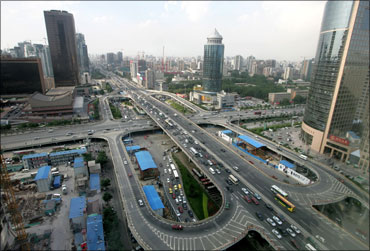 | « Back to article | Print this article |
Where India can benefit from Chinese investments
India and China are currently holding their first-ever Strategic Economic Dialogue.
This is along the lines of a similar dialogue between the US and China, and to that extent, is a Great Powers powwow. One is on the verge of Great Power status; the other is just a seeker.
One projects hard power and membership of the United Nations Security Council; the other is the soft-power mascot, knocking on UNSC's door.
Whatever may be their differences, they take each other seriously.
There is a yin and yang aspect to their relations - a better way to describe it would be "sweet and sour".
Witness some of the recent happenings.
There is the spat in South China Sea, where India's right to traverse the sea and explore deep-sea hydrocarbons in international waters has been challenged by China's navy.
Or the case of stapled visas for Kashmiris to irritate Indian authorities.
Then there is the ever thorny (for the Chinese) issue of Tibet, whose government is in permanent residence in India, and territorial integrity of Arunachal Pradesh (where great wealth in the form of shale oil resides).
And then there is the alarm caused by the string of pearls China bases around India, as also the development of the military port of Gwadar in Pakistan.
Click NEXT to read more...
Where India can benefit from Chinese investments
China is now India's biggest trading partner: the business has grown from zero to $60 billion in less than a decade, with a further doubling expected in the next four years.
The bulk of India's $100-billion worth power sector equipment will be sourced from China in the next five years.
Imports in the power sector are now hitting a wall, since Indian banks can no longer finance these purchases.
Hence, Chinese banks are stepping in. Firms like Anil Dhirubhai Ambani Group have managed to get substantial yuan loans for their Chinese imports.
In recognition of this development, the Reserve Bank of India allows up to 1 billion yuan to be taken as direct commercial borrowing. Of course, given the huge requirement, this is barely five per cent of the potential. In the telecommunications sector too, the switches and hardware are increasingly Chinese.
In fact, Huawei has become an Indian telecom brand, with famous author Chetan Bhagat as ambassador.
RBI recently granted licence to a Chinese bank, Industrial and Commercial Bank of China.
ICBC, the world's largest bank by market cap, profits and assets, will invest about half a billion US dollars as initial capital in India.
Click NEXT to read more...
Where India can benefit from Chinese investments
The Panchsheel (five foundations) principles included: respect for territorial integrity, non-aggression, non-interference in internal affairs, equality and peaceful coexistence.
At that time, both countries were firmly in the Third World camp.
It may be useful to recall that the term "Third World" was used by Mao Zedong to describe nations like India and China, as part of the non-aligned club.
Despite the early bonhomie, or perhaps because of its artificiality, the next 40 years saw the two neighbours drifting into enemy camps, with China developing an all-weather, well-cemented friendship with Pakistan.
Post-liberalisation, however, both India and China have been constantly crossing each other's paths, if not colliding - whether in international fora like G20, World Trade Organisation and climate change talks or about bilateral trade and border disputes.
While SED aims to find ways to increase trade and investment flows and enable increased co-operation, two suggestions may be readily implementable and mutually beneficial.
The first is regarding Chines foreign direct investment in India's infrastructure.
With a pile of $3 trillion of foreign exchange, China is under pressure to diversify into non-dollar assets.
Click NEXT to read more...
Where India can benefit from Chinese investments
According to a wag, the Chinese are overpaying wildly, and spending as if the dollar is going out of fashion.
And it might become a self-fulfilling prophecy, although these past weeks belie that possibility about the demise of the mighty dollar.
Even if the Chinese channel three per cent of their forex stock (about $100 billion) into a 30-year fixed return investment into India's infrastructure, that would be a win-win proposition.
It could be (sovereign) guaranteed with an eight per cent yuan-denominated return by India, eliminating any currency risk for the Chinese.
In any case, India has a widening trade deficit with China, which needs to be financed by the yuan.
So the capital account FDI inflow would fit perfectly.
As for the sovereign guarantee, if Enron was justified, why not China's investment?
The Japanese have already set a precedent by investing long term in the Delhi Metro and the Delhi-Mumbai Corridor.
The second suggestion is to start local currency invoicing. Indian exporters should be allowed to invoice in the rupee and China's exporters in the yuan.
Click NEXT to read more...
Where India can benefit from Chinese investments
In some of the recent power equipment sourcing deals, Chinese manufacturers have offered five to 10 per cent discounts if paid in the yuan.
It allows them to be insulated from dollar fluctuations. That is a good reason for RBI and India's policy makers to encourage yuan invoicing, since this saving could directly translate into savings for India's power sector.
To facilitate rupee-yuan deals, a swap arrangement between the two central banks can fix appropriate exchange rates and ensure liquidity support.
This reduces transaction costs and will lead to eventual internationalisation of the currencies. (With both aspiring for Great Power status, surely that's a commonly shared goal?)
Even though China enjoys huge trade surplus with India, its own capital surplus allows it to increasingly finance India's consumption and investment financing needs.
Even though there are safeguards and anti-dumping duties to protect Indian producers, the usefulness of Chinese FDI in India's infrastructure cannot be doubted.
As for yuan invoicing, its time has already come.
The author is chief economist, Aditya Birla Group
Views expressed are personal





